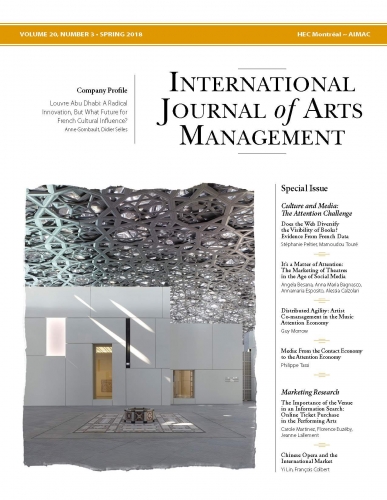Louvre Abu Dhabi: A Radical Innovation, But What Future for French Cultural Influence?
Product: Article
$21.00 CA
Anne Gombault, Didier Selles
Anne Gombault is a professor of Management and Director of the research centre for Arts and Creative Industries Management at the Kedge Business School in France. After completing her thesis on the Grand Louvre strategy in 2000, she worked at the Louvre Museum until 2012, completing a follow-up study on the Très Grand Louvre during the presidency of Henri Loyrette, when the Abu Dhabi project was launched.
Didier Selles is Senior Advisor to the Court of Auditors in France. From 2000 to 2009 he was Managing Director of the Louvre Museum. From 2005 to 2007 he served as negotiator on behalf of the Louvre for the Abu Dhabi agreement, responsible in particular for ensuring the protection of the Louvre brand name and and for achieving an exceptional valuation for the museum’s expertise.
ABSTRACT
The Louvre Abu Dhabi was inaugurated in late 2017, 10 years after the 2007 signing of an intergovernmental agreement between France and the United Arab Emirates. This article, written from a French insider perspective, is the result of a longitudinal strategic “conversation” between a researcher who observed the strategic management of the project at the Louvre and the museum’s Managing Director at the time, who negotiated the Louvre Abu Dhabi project. The study analyzes not only the radical managerial innovation but also how little has been learned concerning international policy at the Ministry of Culture and France’s major museums. It looks at the issues raised and offers recommendations regarding the future of the Louvre Abu Dhabi, the Louvre Museum and French cultural influ
KEYWORDS
Superstar museum, managerial innovation, governance, branding, influential power, cultural district
RÉSUMÉ
Fin 2017, le Louvre Abu Dhabi était inauguré, 10 ans après la signature de l’accord intergouvernemental entre la France et les Émirats Arabes Unis. Depuis une perspective française, cet article est issu d’une conversation stratégique longitudinale entre le chercheur qui a observé le management stratégique du projet au Louvre et l’administrateur général du musée à l’époque qui a négocié le projet. L’étude analyse cette innovation managériale radicale de même que le faible apprentissage qui en a résulté pour la politique internationale du ministère de la Culture et des grands musées de France. Il questionne les enjeux et propose des recommandations pour l’avenir du Louvre Abu Dhabi, pour le Louvre lui-même et pour l’influence culturelle française. Enfin, il permet de mieux comprendre les stratégies internationales des musées superstars.
MOTS CLÉS
Musée superstar, innovation managériale, gouvernance, image de marque, pouvoir d’influence, quartier culturel
RESUMEN
El Louvre de Abu Dabi fue inaugurado a fines de 2017, diez años después de la firma del acuerdo intergubernamental entre Francia y los Emiratos Árabes Unidos en 2007. Para alguien que en Francia ha seguido de cerca este tema, este artículo presenta el resultado de una conversación estratégica longitudinal entre un investigador que estuvo observando la gestión estratégica del proyecto en el Louvre y el director ejecutivo que en la época negoció el proyecto. En este artículo se analiza mencionada innovación radical en materia de gestión y se destaca el hecho de que el Ministerio de la Cultura y los principales museos franceses sacaron de dicha experiencia pocas lecciones en el ámbito de la política internacional. Se estudia también el conjunto de problemas que surgen y da recomendaciones para el futuro del Museo Louvre de Abu Dabi, el Louvre mismo, y la influencia cultural francesa. Finalmente, contribuye a una mejor comprensión de las estrategias internacionales de los museos estrellas.
PALABRAS CLAVE
Museo estrella, innovación en la gestión, gobernanza, imagen de marca, poder de influencia, distrito cultural

